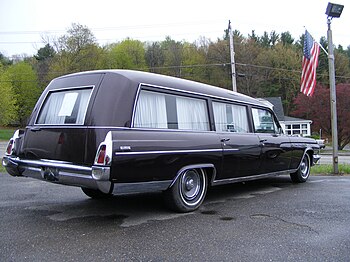| (Photo credit: Wikipedia) |
There are so many police duties that are misrepresented in media that I was pleased to be able to speak with a law enforcement professional about this aspect of their job. Karla (her full name and agency will remain anonymous for privacy's sake) is a 15 year POST Certified Law Enforcement Officer with a Masters Degree in Psychological Counseling. She is also a Licensed Professional Counselor and a Licensed Marriage and Family Therapist. Karla has been working with victims and their families for over 21
years and has made hundreds of death notifications.
In order to make a successful death notification……you have to CARE.
Karla -
I would never give a death notification over the phone. Even if we have to make a notification to someone out of state, I would contact a LE agency in that person’s area and have them go to make personal contact. You have no control over a situation if you
Regarding death notifications, the shift supervisor would contact me when there is a need. I would gather the exact name of the deceased and the name of the person I need to notify, and I make SURE that I contact the correct person.
I obtain the details of how the victim died, and I will provide that (to a certain extent but will spare “gory” details when I can). When I deliver the actual news.
Fiona -
What are some of the typical reactions you see when you offer a family your information.
Karla -
People react to trauma differently. I have had people try to attack me and tackle me to the ground, and I have had those that just stare at me with a blank stare and no reaction at all.
Usually, they beg me to tell them that “it’s not true” and cry and sob. Most immediately want to go to their loved one and see them. Sometimes it is not possible, and those cases are the hardest because the families need closure/proof that their loved one has really died.
Karla -
Each case is different in terms of how long I will stay with a victim. I make it a common practice to make sure another relative or friend arrives to support them before I leave the survivor. Typically, I will remain for about an hour.
I have been referred to as the “Grim Reaper” and the “Angel of Death.” Someone once told me that they wouldn’t take my job for a million dollars. Aside from these comments, there are the people who are so grateful that I showed compassion and empathy when bringing them the most difficult news of their lives…..they are the people who enable me to continue this difficult task year after year. I care about each and every one of them that I have ever had contact with.
Fiona -
Karla, I can truly sense your deep care. What a wonderful gift to the families at their lowest most difficult point to have someone who is sensitive and strong there for them. I imagine those negative comments come from people who are deeply afraid and want to distance themselves from the possibilities in their own lives. I personally am so very grateful knowing that there are people out there like you who have the capacity to do this job.
Fiona -
Welcome, Karla. My first question for you is about the level of training an officer gets to perform the task of death notification. Surely, your credentials and level of expertise are unique.
Karla -
Death notification is one of the most difficult tasks in our profession. Most LE (law enforcement) officers receive training during the police academy, but it is usually brief and limited training.
Karla -
Death notification is one of the most difficult tasks in our profession. Most LE (law enforcement) officers receive training during the police academy, but it is usually brief and limited training.
I teach this topic in our academy. There are other organizations such as Mothers Against Drunk Driving that offers this training to LE agencies. Some agencies, such as ours, have officers that specialize in this task and many use an Agency Chaplain for this role.
In order to make a successful death notification……you have to CARE.
Fiona -
What happens when it's a small town? Do they have trained personnel come in from a bigger dept?
Karla -
Small town agencies can deliver notifications just as well as larger departments – they just need to provide the right training for their officers and the training is available.
Fiona -
What kinds of interventions do you do in person versus over the phone?
What kinds of interventions do you do in person versus over the phone?
Karla -
I would never give a death notification over the phone. Even if we have to make a notification to someone out of state, I would contact a LE agency in that person’s area and have them go to make personal contact. You have no control over a situation if you
make the notification over the phone. Someone could attempt to
harm themselves after they receive the news, and you would never know. I make notifications in person for deaths and serious injuries. I will go to wherever that person is. I have even boarded a helicopter to make a notification to someone working offshore on an oil platform.
| (Photo credit: Official U.S. Navy Imagery) |
Regarding death notifications, the shift supervisor would contact me when there is a need. I would gather the exact name of the deceased and the name of the person I need to notify, and I make SURE that I contact the correct person.
I obtain the details of how the victim died, and I will provide that (to a certain extent but will spare “gory” details when I can). When I deliver the actual news.
Fiona -
What are some of the typical reactions you see when you offer a family your information.
Karla -
People react to trauma differently. I have had people try to attack me and tackle me to the ground, and I have had those that just stare at me with a blank stare and no reaction at all.
Usually, they beg me to tell them that “it’s not true” and cry and sob. Most immediately want to go to their loved one and see them. Sometimes it is not possible, and those cases are the hardest because the families need closure/proof that their loved one has really died.
Fiona -
Have you ever had anyone go into shock or need medical intervention after receiving the news?
Karla-
I try to find out if the survivor has any type of medical condition (such as heart problems, mental issues, or pregnancy) and I contact the ambulance service and have them “standby” down the street from where I’m making the notification. I have never had to use them thus far.
Fiona -
Under what circumstances can they not see the body.
Karla -
If the deceased in part of a crime scene, the family cannot see the body. This is for evidentiary purposes. In those cases, they would have to wait until the coroner releases the body and would have to go to the funeral home to view their loved one. On occasion, they may go to the coroner’s office. I have also had cases where the body was so damaged that there wasn’t much left to see.
Fiona -
Do they need to go and identify the body?
Karla -
I have only had a rare few cases where we needed a family member to identify the body, and when that happens, they go to the coroner’s office.
Karla -
I have only had a rare few cases where we needed a family member to identify the body, and when that happens, they go to the coroner’s office.
If the survivor has to go to another location to view the body, such as the funeral home or coronor’s office, I always go with them.
Fiona -
How does your department go about finding the next of kin or someone to inform? Say that they were an unmarried adult orphan without any obvious family ties?
Karla -
We have an extensive LE database that we use and can usually find a next-of-kin within an hour or two. Only in cases where we are delayed in identifying the victim does it take longer than a couple of hours. In those cases, we may have to finger print the victim or work with other LE agencies for identification.
| (Photo credit: The Library of Congress) |
Notifications to children are extremely hard. I always make sure that an adult that the child trusts is with me.
Fiona -
Fiona -
What do you do if the deceased are the parents and the children are home alone?
Karla -
If I have to notify a minor child, I make contact with another adult relative first and take that relative
Karla -
If I have to notify a minor child, I make contact with another adult relative first and take that relative
with me to make contact with the child.
Fiona-
What if it is a child who died and there is joint custody/separate residence - do you seek out both parents?
Karla -
If it is a child and joint custody is in effect; ideally I like both parents present but will make the notification with one present if I have to. I don’t want to delay a notification because news travels fast in south Louisiana and I don’t want them to find out that way. That is another topic….social media! It becomes a nightmare when a tragedy happens.
Fiona -
Yes - how has social media changed things - have you ever arrived to panicking family who just read something on Facebook?
Karla -
| (Photo credit: Wikipedia) |
Social media has certainly made this difficult. Often, we arrive to deliver a notification and someone has already read about the tragedy on Facebook or worse, someone has sent the survivor a message or even a picture of the scene! I can just imagine how awful that must be to receive something like that. I have
had many situations where I was in the midst of delivering the notification and the survivor’s cell phone get going off with social media notifications.
Fiona -
How long is your typical contact in terms of staying at the initial point of contact and making sure everyone is stable?
Karla -
Each case is different in terms of how long I will stay with a victim. I make it a common practice to make sure another relative or friend arrives to support them before I leave the survivor. Typically, I will remain for about an hour.
Fiona -
You've seen the notification process portrayed on the TV and other media. What common mistakes do you see that you would like people to know are untrue? Are there any other aspects of your job that you would like to convey?
Karla -
I don’t like the way TV portrays death notifications when the officers appear so cold and calloused. We are not all like that. Some of us care very much about the people that we have to notify because someday, we may be on the receiving end of a notification.
Some of my notifications have been very difficult. One that stands out in my mind involved an elderly man that was killed in a farming accident. I went to his home to notify his wife and found her sitting at the kitchen table with a birthday cake on the table. It was her birthday, and she was waiting for her husband to come home so they could light her candles.
You've seen the notification process portrayed on the TV and other media. What common mistakes do you see that you would like people to know are untrue? Are there any other aspects of your job that you would like to convey?
Karla -
I don’t like the way TV portrays death notifications when the officers appear so cold and calloused. We are not all like that. Some of us care very much about the people that we have to notify because someday, we may be on the receiving end of a notification.
| Calla Light Bulb (Photo credit: big/sara) |
I have been referred to as the “Grim Reaper” and the “Angel of Death.” Someone once told me that they wouldn’t take my job for a million dollars. Aside from these comments, there are the people who are so grateful that I showed compassion and empathy when bringing them the most difficult news of their lives…..they are the people who enable me to continue this difficult task year after year. I care about each and every one of them that I have ever had contact with.
Fiona -
Karla, I can truly sense your deep care. What a wonderful gift to the families at their lowest most difficult point to have someone who is sensitive and strong there for them. I imagine those negative comments come from people who are deeply afraid and want to distance themselves from the possibilities in their own lives. I personally am so very grateful knowing that there are people out there like you who have the capacity to do this job.
So a heartfelt thank you.
See how this article influenced my plot lines in my novella MINE and my novel CHAOS IS COME AGAIN.
See how this article influenced my plot lines in my novella MINE and my novel CHAOS IS COME AGAIN.




















